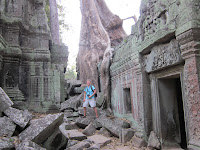Exploring the mountains of collapsed stones and hidden passageways, we spent several hours here and loved the atmosphere. Ta Prohm provided us the emotional connection to the past that no other temple had heretofore afforded.
After exploring Ta Prohm, we stopped to eat and asked Set to join us for lunch over which we learned that he is married with a 3 year old daughter. He also goes to school in the morning from 7:30 – 8:30 to study English. We asked why he did not also provide tour guide services and he explained that in order to get a license, course work costing $2,000.00, which he could not afford, had to first be completed.
After lunch we visited Preah Khan. Situated just north and a slight bit east of Angkor Thom, it was built around 1191. For a perspective on the 12th Century in the rest of the world, Notre Dame Cathedral was being built, in Paris, around this same time. Preah Khan was more than just a temple. It was a Buddhist university with over 1,000 teachers, and a considerable city. A moat surrounds this city, thus it has entrance causeways lined with Gods holding a Naga tail.
Preah Khan is very similar to Ta Prohm in that it is in a natural state of ruin, reclaimed by the jungle and choked by strangler figs and silk cotton trees. We spent several hours exploring this beautiful temple and imagining what it was like to find it in the early 1900's. In one of the courtyards we spotted 2 young painters, their portfolio spread, on the path, at their feet. Their paintings were fantastic!!
P- Wow! Look at their paintings. They are very good.
G- They are. Let's take a few pictures over here, then look at them. I like the one on top, of the tree in Ta Prohm.
We took our photos and when we returned, they were wrapping a painting for another tourist who had made a purchase. He said, “they are very good! I have seen painters all around Cambodia, but these 2 are the best. And so young.”
P- We agree, that's why we came back to see what they had and buy one.
G- (we looked through the paintings) I really like this one.
P- I like that one too. But I want that one of the Ta Prohm tree. Do you see it?
G- No, I can't find it.
Artist – Which one you want?
P- The one of the tree on Ta Prohm.
Artist – That man you talk to , he buy it.
G- Damn! What are the odds of that?! That's the one we came back to buy.
P- Whah! Flashback from Ubud. Why can't we buy a painting that we like?
G- I do like the one of the 4 headed towers of Bayon.
P- I like that one too, but I really want the one of the tree. Do you have any other paintings of the Ta Prohm tree?
Artist – No, but I make another for you. You come back tomorrow?
G- No, we're not coming back here.
Artist – Where you stay? In Seim Reap?
P – Yes.
Artist – I can make one and bring it to you. What is your guesthouse?
G- You'll make another one this afternoon and bring it to us tonight?
Artist – Yes. But cannot paint the tree at Ta Prohm. My brother and I will find a tree here, like tree at Ta Prohm, and paint it.
P- Gi, that ok with you?
G- Yes, that might be even cooler because they're painting it just for us. And I really like Preah Khan too. I'm good with that.
P- Ok, you'll come to our guesthouse tonight?
Artist – Yes. Where is it? What time will you be there?
G- Meet us at Rosie's Guesthouse. It is along the river. Do you know it?
Artist – No.
G- Wait! I have a card in my pocket. (I handed him the card.) Meet us there at 7:00 pm. Is that ok?
Artist – Yes. We will paint it and meet you there at 7 o'clock.
P- You promise that you will come?
Artist – Yes, yes. We come.
G- Ok, and please bring this one too and we'll buy both.
We negotiated a price of $30.00 for the 2 paintings, and left hoping that the brothers would come to the guesthouse as promised. After the Ubud incident, we were nervous.
It is often said that the Temples of Angkor Wat were “discovered” in the early 20th Century. This is western idea much like the notion that Columbus “discovered” America even though people had been living there for hundreds of years, and it's likely that the Chinese landed on the continent before the Europeans. The Temples of Angkor were always known to the people living in and around Cambodia. It was only that they came to the attention of the western world in the early 20th Century.
Finally, we stopped at Banteay Kdei, just southeast of Ta Prohm. Built in the late 12th – early 13th Century, it is believed to have been built on the ruins of a 10th Century temple. This temple is also in a state of disrepair akin to Ta Prohm & Preah Khan, but lacks the charm of those 2 temples. It does contain many well preserved Apsaras in the Hall of Dancers, but overall is smaller and less preserved. Set had admonished us not to save too much time for this temple and he was correct.
















